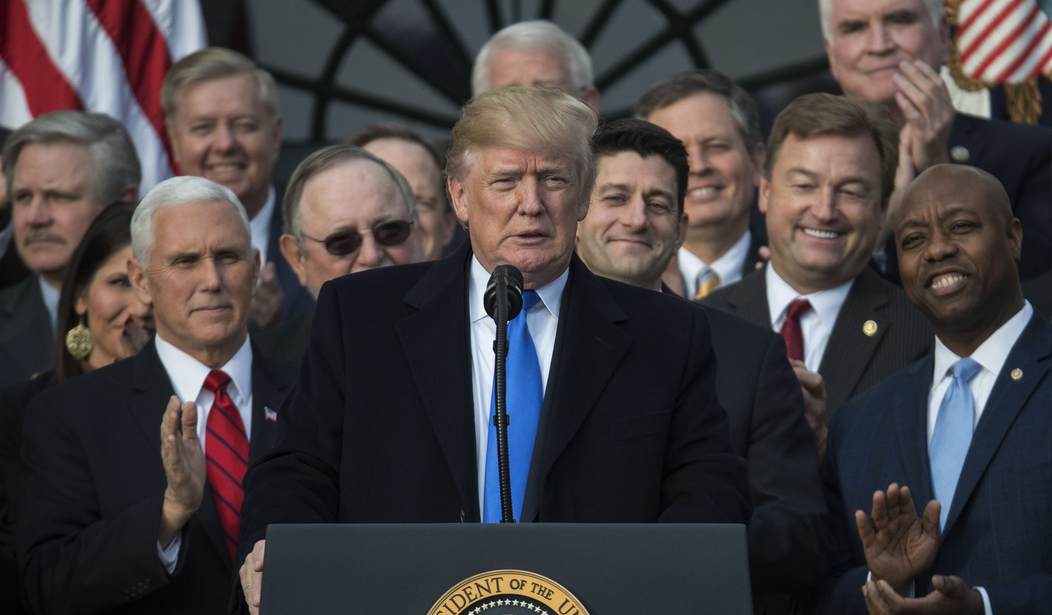With President Trump's signing of the big tax cut bill, the Republican Party snatched victory from the jaws of defeat. Suddenly, the political and economic landscapes have changed. The GOP has turned the tables on the Democrats.
With the passage of this powerful tax-cut legislation to boost business investment, wages and take-home family pay, Trump and the GOP are on the side of the growth angels. The Democrats, meanwhile, are left with stale class-warfare slogans about tax cuts for the rich.
Ironically, government unions, with their pension plans heavily invested in equity shares, will benefit hugely from the tax-cut-led stock market boom. They boo the GOP bill while they should be cheering.
But there's a lot of irony to go around. Unlike the pro-growth tax-cut party of former President John F. Kennedy, today's left-lurching Democrats root against economic growth, the stock market and a powerful prosperity at home that lends strength abroad. This is not a good place for Democrats to be.
If the supply-side business tax cuts perform as well as I believe they will, Trump and the GOP, with the stroke of a pen, will have greatly enhanced their outlook for the midterm elections.
One of the more incredible things about this story is the almost immediate support of large companies. Bank of America announced a $1,000 bonus for about 145,000 employees in response to the tax-cut bill. And AT&T and Comcast announced $1,000 bonuses for more than 300,000 people combined, along with substantial new investments in the United States. Ditto investments for Boeing. And more banks have joined the parade. Wells Fargo, PNC, BB&T and Fifth Third Bancorp are raising their minimum wages to $15 an hour.
Recommended
All this is tied to a massive corporate tax rate deduction from 35 to 21 percent. This is the most powerful growth measure in the plan. Trump called these workers' bonuses tax "love" in a tweet.
At the old 35 percent rate, our companies took home 65 cents on the extra dollar. At the new 21 percent rate, they'll take home 79 cents. This enormous 21 percent incentive rewards new risk-taking, investment, a recycling of overseas profits to the U.S. and additional after-tax profitability.
Combined with 100 percent immediate cash write-offs for new investment and the one-time repatriation of foreign-held earnings, this is the largest supply-side stimulus since 1986.
The result will be a business boom, where new capital formation and productivity increases the economy's potential to grow. This is counter-inflationary. We can say goodbye to 1 or 2 percent secular stagnation and hello to 3 to 4 percent long-run prosperity. And when you toss in lower marginal tax rates for individuals and the doubling of the standard deduction, you have even more potential for growth.
In a recent Tax Foundation analysis by President Scott Hodge, he notes that even the lowball Joint Committee on Taxation agrees the tax cuts pay for themselves. How? More gross domestic product will be generated than revenues lost to the Treasury. For every dollar lost, the tax cuts produce roughly $1.90 in additional GDP.
Also from the Tax Foundation is the assertion that the biggest tax liability reductions will come to the middle class, as shown through several examples. A single parent who earns $52,000 and has two children claims a 36 percent reduction in tax liabilities. A single-earner married couple with two children that makes $85,000 and files jointly gets a 20 percent tax-revenue reduction. And a married single-earner couple with two children that files jointly and earns $2 million only gets a 3 percent reduction in tax liabilities. So much for the tax-cuts-for-the-rich argument.
Let's not forget that the plan includes Arctic National Wildlife Refuge drilling access and the repeal of the Obamacare individual mandate. Let's also not forget the Trump administration's massive reductions of burdensome business regulations.
At the end of the day, the success of the Trump tax cuts will not be decided by Democrat-leaning polls or highly flawed econometric models. The proof in this pudding will be in the eating.
With the supply-side model of lower marginal tax-rate incentives to work, save and invest, plus significantly less tax avoidance and sheltering, the economy will move back to its normal steady-state pattern of 3 to 4 percent growth.
Already in the past two quarters we've seen a bump in business-equipment investment, producing better than 3 percent growth. The fourth quarter is likely to remain above 3 percent. The results of lower withholding rates accompanied by higher income-bracket thresholds will show up in February.
More take-home pay is always a winner. And businesses large and small are beginning to pull the investment trigger. Yes, the middle class will benefit. But everyone will profit from the first business boom in over 20 years.
President Kennedy, President Ronald Reagan, the late Jack Kemp, economist Art Laffer and the rest of the supply-side clan -- which now includes Donald Trump -- believes that a rising tide lifts all boats.
So which is better: 1 to 2 percent stagnation, or 3 to 4 percent prosperity?
Let the voters decide next year. But I'm taking the high ground.



















Join the conversation as a VIP Member